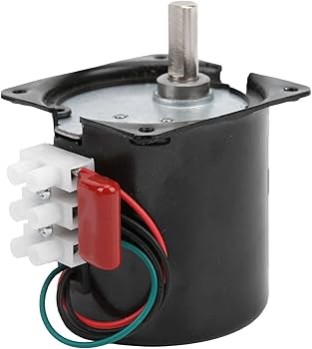








59TYD-375-2B AC Synchronous Motor 220VAC 50HZ - 60 RPM
he 59TYD-375-2B AC Synchronous Motor you're referring to is a specific type of AC synchronous motor with the following key features:
₹ 950 ₹1,250
1,250




| Made In : | India |
Add FAQ
The 59TYD-375-2B AC Synchronous Motor you're referring to is a specific type of AC synchronous motor with the following key features:
Key Specifications:
-
Voltage Rating:
- 220V AC: The motor operates at a voltage of 220 volts AC, which is common in many regions around the world, particularly in Europe, Asia, and some other parts of the world.
-
Frequency:
- 50 Hz / 60 Hz: The motor can operate at both 50Hz (common in Europe, Asia, Africa, and most of the world) and 60Hz (common in North America, parts of South America, and a few other regions). The frequency determines the speed at which the motor operates in relation to the number of poles in the motor and its synchronous speed.
-
Speed:
- 60 RPM: The motor runs at a constant speed of 60 revolutions per minute (RPM). This is a typical speed for synchronous motors, where the motor speed is directly related to the frequency and the number of poles of the motor.
Motor Type: Synchronous Motor
- A synchronous motor runs at a fixed speed (determined by the supply frequency and the number of poles in the motor). Unlike induction motors, which operate at a speed slightly less than the synchronous speed (due to slip), synchronous motors maintain a precise speed of rotation once they are synchronized with the power supply frequency.
How It Works:
-
Synchronous Motors: These motors are designed to run at a speed that is exactly synchronized with the supply frequency. For example, at 50 Hz, the motor will rotate at 60 RPM, and at 60 Hz, it will rotate at 72 RPM if it is a 2-pole motor. The motor's speed depends on the supply frequency and the number of poles the motor has.
- In your case, the motor is likely a 2-pole synchronous motor, meaning the number of poles and the supply frequency result in a speed of 60 RPM at 50Hz.
-
Starting Mechanism: Synchronous motors typically require some method of starting because they need to be brought to near synchronous speed before they can lock into phase with the supply frequency. Once it starts, it runs at synchronous speed without any slip.
Applications of Synchronous Motors:
Synchronous motors are commonly used in applications where maintaining a constant speed is crucial. Some common uses include:
- Clocks and timekeeping equipment: Synchronous motors are used in precision timing applications because of their fixed speed.
- Industrial machinery: For driving equipment that requires constant-speed operation, such as conveyors, pumps, and fans.
- Generators: They can be used in generating stations to convert mechanical energy into electrical energy.
- Audio equipment: Synchronous motors are sometimes used in turntables or other devices requiring very precise rotation speeds.
Advantages of AC Synchronous Motors:
- Constant Speed: Once synchronized, the motor runs at a constant speed regardless of load variations, making it ideal for applications requiring precision.
- No Slip: Unlike induction motors, synchronous motors do not exhibit slip, meaning the rotor speed is exactly in sync with the supply frequency.
- Energy Efficiency: They are often more energy-efficient than induction motors, especially at full load.
Possible Applications for the 59TYD-375-2B:
Based on the specifications you provided (220V AC, 60 RPM), the motor could be used in:
- Clock drives
- Small industrial machines requiring low-speed and high-precision control
- Fans or blowers in air conditioning systems
- Turntables or rotating displays
- Pumps or mixers in processes requiring consistent low-speed operation
If you're looking for more information on how to wire or use this motor, or if you need a specific datasheet for the 59TYD-375-2B motor, let me know!

0 Reviews For this Product





3.jpeg&width=225&quality=80)







